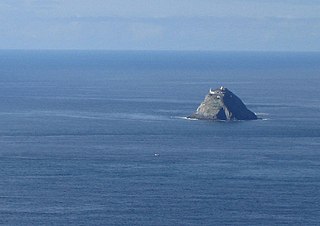
In Irish mythology, Donn is an ancestor of the Gaels and is believed to have been a god of the dead. Donn is said to dwell in Tech Duinn, where the souls of the dead gather. He may have originally been an aspect of the Dagda. Folklore about Donn survived into the modern era in parts of Ireland, in which he is said to be a phantom horseman riding a white horse.
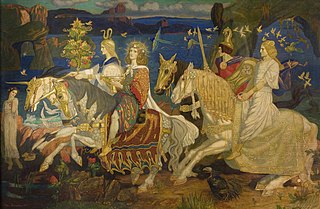
Irish mythology is the body of myths indigenous to the island of Ireland. It was originally passed down orally in the prehistoric era. In the early medieval era, some myths were transcribed by Christian monks, who heavily altered and Christianised the myths. Irish mythology is the best-preserved branch of Celtic mythology.

The TuathaDé Danann, also known by the earlier name Tuath Dé, are a supernatural race in Irish mythology. Many of them are thought to represent deities of pre-Christian Gaelic Ireland.
In Welsh mythology, Amaethon was the god of agriculture, and the son of the goddess Dôn. His name means "labourer" or "ploughman", and he is cited as being responsible for the Cad Goddeu, or "Battle of Trees", between the lord of the otherworld, Arawn, and the Children of Dôn.
Annwn, Annwfn, or Annwfyn is the Otherworld in Welsh mythology. Ruled by Arawn, it was essentially a world of delights and eternal youth where disease was absent and food was ever-abundant. It became identified with the Lutheran afterlife in paradise.
In Welsh mythology, Arawn was the king of the otherworld realm of Annwn who appears prominently in the first branch of the Mabinogi, and alluded to in the fourth. In later tradition, the role of the king of Annwn was largely attributed to the Welsh psychopomp, Gwyn ap Nudd - meaning "white" a possible kenning for his true name. However, Arawn's memory is retained in a traditional saying found in an old Cardigan folktale:
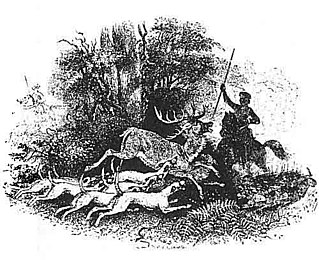
Pwyll Pen Annwn is a prominent figure in Welsh mythology and literature, the lord of Dyfed, husband of Rhiannon and father of the hero Pryderi. Meaning ''wisdom" he is the eponymous hero of Pwyll Pendefig Dyfed, the first branch of the Four Branches of the Mabinogi, and also appears briefly as a member of Arthur's court in the medieval tale Culhwch ac Olwen. Pwyll, Prince of Dyfed also carries many similarities to the Mabinogi Branwen.
Hafgan is one of the kings of Annwn, the otherworld in Welsh mythology. He appears in the First Branch of the Mabinogi as the main rival of Arawn, the other king of Annwn. The dominions of the two kings sit side by side, and Hafgan is constantly warring against Arawn. In the story Pwyll, Prince of Dyfed, Pwyll, in order to gain Arawn's friendship, agrees to switch places with him for one year and one day and to battle against Hafgan in order to rid Arawn of his difficulty. Before they exchange places, Arawn gives specific instructions to Pwyll to kill him with one stroke and no more. In the past when Arawn had battled and had struck Hafgan nearly to his death, Hafgan had begged him to give another stroke, and when Arawn had done so, Hafgan recovered from his injuries and was in good health for battle again the next day."
In Welsh mythology and folklore, Cŵn Annwn, singular Ci Annwn, were the spectral hounds of Annwn, the otherworld of Welsh myth. They were associated with a form of the Wild Hunt, presided over by either Arawn, king of Annwn in Pwyll Pendefig Dyfed, the First Branch of the Mabinogi and alluded to in Math fab Mathonwy the Fourth Branch of the Mabinogi, or by Gwyn ap Nudd as the underworld king and king of the fair(y) folk is named in later medieval lore.
In Irish mythology, Mag Mell is one of the names for the Celtic Otherworld, a mythical realm achievable through death and/or glory. Unlike the underworld in some mythologies, Mag Mell was a pleasurable paradise, identified as either an island far to the west of Ireland or a kingdom beneath the ocean. However, Mag Mell was similar to the fields of Elysium in Greek mythology, and, like the fields of Elysium, was accessible only to a select few. Furthermore, Mag Mell, like the numerous other mystical islands said to be off the coast of Ireland, was never explicitly stated in any surviving mythological account to be an afterlife. Rather, it is usually portrayed as a paradise populated by deities, which is occasionally visited by some adventurous mortals. In its island guise it was visited by various Irish heroes and monks forming the basis of the Adventure Myth or "echtrae" as defined by Myles Dillon in his book Early Irish Literature. This otherworld is a place where sickness and death do not exist. It is a place of eternal youth and beauty. Here, music, strength, life and all pleasurable pursuits come together in a single place. Here happiness lasts forever, no one wants for food or drink. It is the Irish equivalent of the Greek Elysium or the Valhalla of the Norse.

Welsh mythology consists of both folk traditions developed in Wales, and traditions developed by the Celtic Britons elsewhere before the end of the first millennium. As in most of the predominantly oral societies Celtic mythology and history were recorded orally by specialists such as druids. This oral record has been lost or altered as a result of outside contact and invasion over the years. Much of this altered mythology and history is preserved in medieval Welsh manuscripts, which include the Red Book of Hergest, the White Book of Rhydderch, the Book of Aneirin and the Book of Taliesin. Other works connected to Welsh mythology include the ninth-century Latin historical compilation Historia Brittonum and Geoffrey of Monmouth's twelfth-century Latin chronicle Historia Regum Britanniae, as well as later folklore, such as the materials collected in The Welsh Fairy Book by William Jenkyn Thomas (1908).
In Irish mythology, Tír na nÓg or Tír na hÓige is one of the names for the Celtic Otherworld, or perhaps for a part of it. Tír na nÓg is best known from the tale of Oisín and Niamh.

An immram is a class of Old Irish tales concerning a hero's sea journey to the Otherworld. Written in the Christian era and essentially Christian in aspect, they preserve elements of Irish mythology.
The Four Branches of the Mabinogi or Pedair Cainc Y Mabinogi are the earliest prose stories in the literature of Britain. Originally written in Wales in Middle Welsh, but widely available in translations, the Mabinogi is generally agreed to be a single work in four parts, or "branches." The interrelated tales can be read as mythology, political themes, romances, or magical fantasies. They appeal to a wide range of readers, from young children to the most sophisticated adult. The tales are popular today in book format, as storytelling or theatre performances; they appear in recordings and on film, and continue to inspire many reinterpretations in artwork and modern fiction.

Preiddeu Annwfn or Preiddeu Annwn is a cryptic poem of sixty lines in Middle Welsh, found in the Book of Taliesin. The text recounts an expedition with King Arthur to Annwfn or Annwn, the Otherworld in Welsh.
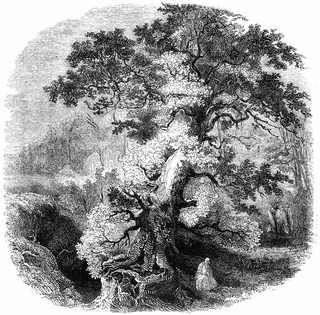
Many types of trees found in the Celtic nations are considered to be sacred, whether as symbols, or due to medicinal properties, or because they are seen as the abode of particular nature spirits. Historically and in folklore, the respect given to trees varies in different parts of the Celtic world. On the Isle of Man, the phrase 'fairy tree' often refers to the elder tree. The medieval Welsh poem Cad Goddeu is believed to contain Celtic tree lore, possibly relating to the crann ogham, the branch of the ogham alphabet where tree names are used as mnemonic devices.
In historical Indo-European religion, the concept of an otherworld, also known as an otherside, is reconstructed in comparative mythology. Its name is a calque of orbis alius, a term used by Lucan in his description of the Celtic Otherworld.

Celtic mythology is the body of myths belonging to the Celtic peoples. Like other Iron Age Europeans, Celtic peoples followed a polytheistic religion, having many gods and goddesses. The mythologies of continental Celtic peoples, such as the Gauls and Celtiberians, did not survive their conquest by the Roman Empire, the loss of their Celtic languages and their subsequent conversion to Christianity. Only remnants are found in Greco-Roman sources and archaeology. Most surviving Celtic mythology belongs to the Insular Celtic peoples. They preserved some of their myths in oral lore, which were eventually written down by Christian scribes in the Middle Ages. Irish mythology has the largest written body of myths, followed by Welsh mythology.
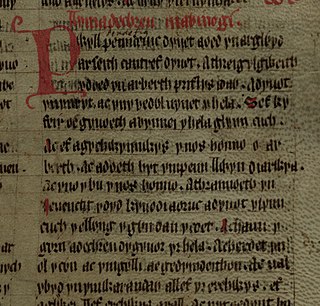
Pwyll Pendefig Dyfed, "Pwyll, Prince of Dyfed," is a legendary tale from medieval Welsh literature and the first of the Four Branches of the Mabinogi. It tells of the friendship between Pwyll, prince of Dyfed, and Arawn, lord of Annwn, of the courting and marriage of Pwyll and Rhiannon and of the birth and disappearance of Pryderi. This branch introduces a number of storylines that reappear in later tales, including the alliance between Dyfed and Annwn, and the enmity between Pwyll and Gwawl. Along with the other branches, the tale can be found in the medieval Red Book of Hergest and White Book of Rhydderch.

The Silver Branch or Silver Bough is a symbol found in Irish mythology and literature.










